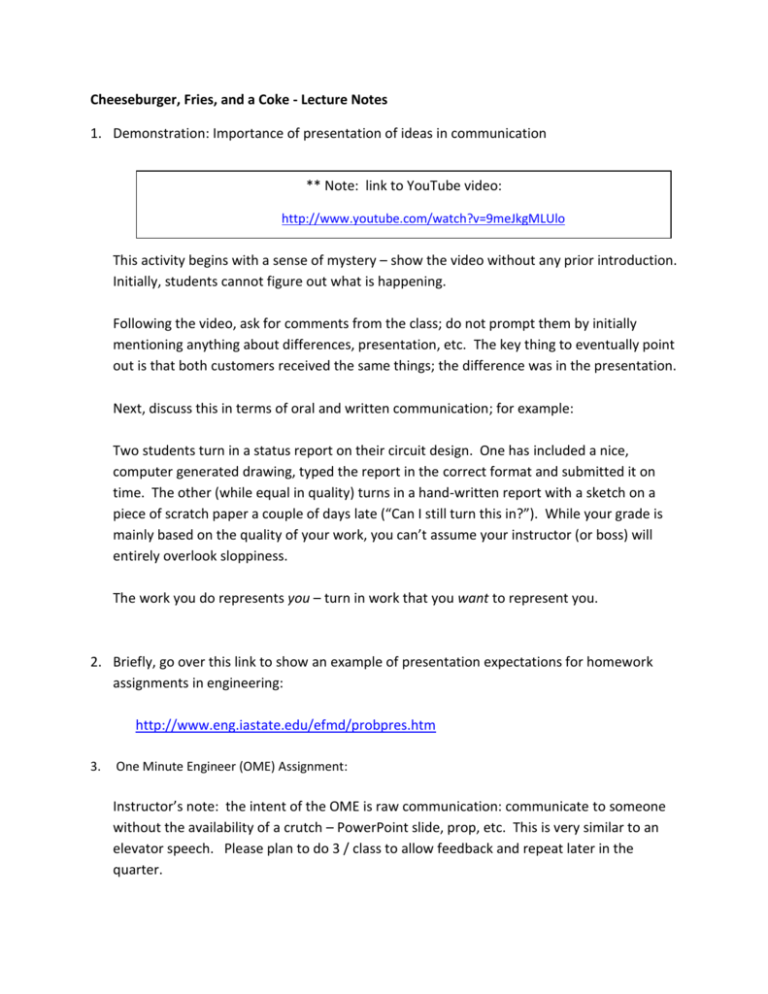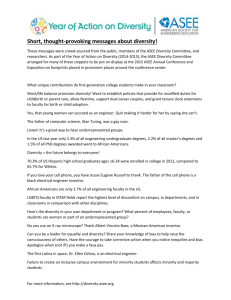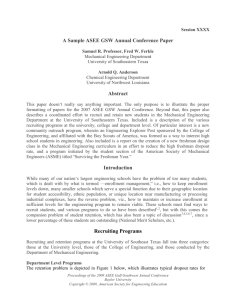Cheeseburger Lecture Notes
advertisement

Cheeseburger, Fries, and a Coke - Lecture Notes 1. Demonstration: Importance of presentation of ideas in communication ** Note: link to YouTube video: http://www.youtube.com/watch?v=9meJkgMLUlo This activity begins with a sense of mystery – show the video without any prior introduction. Initially, students cannot figure out what is happening. Following the video, ask for comments from the class; do not prompt them by initially mentioning anything about differences, presentation, etc. The key thing to eventually point out is that both customers received the same things; the difference was in the presentation. Next, discuss this in terms of oral and written communication; for example: Two students turn in a status report on their circuit design. One has included a nice, computer generated drawing, typed the report in the correct format and submitted it on time. The other (while equal in quality) turns in a hand-written report with a sketch on a piece of scratch paper a couple of days late (“Can I still turn this in?”). While your grade is mainly based on the quality of your work, you can’t assume your instructor (or boss) will entirely overlook sloppiness. The work you do represents you – turn in work that you want to represent you. 2. Briefly, go over this link to show an example of presentation expectations for homework assignments in engineering: http://www.eng.iastate.edu/efmd/probpres.htm 3. One Minute Engineer (OME) Assignment: Instructor’s note: the intent of the OME is raw communication: communicate to someone without the availability of a crutch – PowerPoint slide, prop, etc. This is very similar to an elevator speech. Please plan to do 3 / class to allow feedback and repeat later in the quarter. Suggestion: I like to introduce this with a story about my first terrible public speaking experience: feel free to use mine or tell one of your own. My boss asked me to present our accomplishments on an automated solder joint inspection system to a very important panel of people. I wasn’t very nervous beforehand, because I had a B in speech in college, especially after a particularly good speech on the Michael Stanley Band (and band from Cleveland in the 80’s). On the day of the presentation, I walked into a room of people with obviously high rank in the Navy – there were about 10 people, the room was cramped, and it was hot. The next 10 minutes were terrible – my boss afterward asked if I was all right. What went wrong? o o o Turns out, my speeches on MSB and baseball cards weren’t the best training: ever notice that the students in your HS speech class really didn’t care what you were saying? I had no idea what my environment would be like. Turns out, I should have visited the room to see how cramped it was beforehand. The problem wasn’t so much the size of the room as the surprise at the size of the room. Also, it may have helped to practice beforehand! So what? o Who likes public speaking? o Who thinks that, sometime, they will have to speak in public? (hopefully everyone) o It is better to give it a shot in an environment where you will get feedback to help you improve, where everyone is in the same boat and in a friendly place … better than trying for the first time where you could be, well, fired. (don’t worry, I wasn’t fired!) For more information about the use of the One Minute Engineer, please see: Jaeger and Bilen, "The One-Minute Engineer: Getting Design Class Out of the Starting Blocks," Proceedings of the 2006 ASEE Annual Conference, online: http://soa.asee.org/paper/conference/paper-view.cfm?id=1113 Yoder, Jaeger, and Estell, "One-Minute Engineer, Nth Generation: Expansion to a Small Private University," Proceedings of the 2007 ASEE Annual Conference, online: http://soa.asee.org/paper/conference/paper-view.cfm?id=4861 Estell, Laird, and Yoder, "Engineering Personified: An Application of the One Minute Engineer," Proceedings of the 2008 ASEE Annual Conference, online: http://soa.asee.org/paper/conference/paper-view.cfm?id=6852 Alternative to Cheeseburger video - in class demonstration: Select 2 volunteers from the class: someone who would like to perhaps dine out and be treated well. Participants should be seated in front of the class, but at opposite ends of a table. The goal is to treat one student very well: happily place the nice plate, glass and silverware down, spread the napkin on their lap. More or less (angrily or apathetically) toss the bad stuff to the other student – feel free to drop the plate on the floor. Show the class the bottled water (Vanna White style). Happily offer the ‘good’ student some, pour with care. Splash some into the other student’s cup without eye contact. Show the class a plate with 2 doughnuts, Reece’s cups, or similar. Happily offer one to the ‘good’ student, perhaps cutting it for them. Use the nice plate, and ask them if this looks good. Enjoy! Be sure to get your fingers on the food for the ‘bad’ student – build this up: sneeze, drop the food, etc. Skip the eye contact. Follow up with class discussion. ________________________________________________________________________________ Estell, Reid, and Laird, "Cheeseburger, Fries, and a Coke: It's About the Presentation," Proceedings of the 2010 ASEE Annual Conference, online: http://soa.asee.org/paper/conference/paper-view.cfm?id=22661











![AL REPORT ANNU 11] ember 20](http://s2.studylib.net/store/data/012100310_1-59c0c75bebffce8ef3b0a4fee7bf4506-300x300.png)